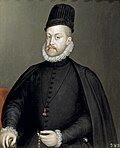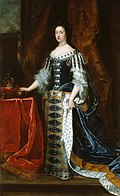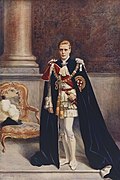List of Canadian monarchs
From Wikipedia, the free encyclopedia
Listed here are the monarchs who reigned over Canada, starting with the French colony of Canada, which subsequently became a British colony, followed by the British Dominion of Canada, and, finally, the present-day sovereign state of Canada.[11] The date of the first claim by a monarch over Canada varies, with most sources giving the year as 1497, when John Cabot made landfall somewhere on the North American coast (likely either modern-day Newfoundland or Nova Scotia) and claimed the land for England on behalf of King Henry VII.[20] However, some sources, instead, put this date at 1535, when the word Canada was first used to refer to the French colony of Canada,[21] which was founded in the name of King Francis I.[22][23] Monarchical governance subsequently evolved under a continuous succession of French, British, and eventually uniquely Canadian sovereigns.[28] Since the first claim by Henry VII,[29] there have been 33 sovereigns of Canada, including two sets of co-sovereigns.[37]
While Canada became a Dominion within the British Empire upon Confederation in 1867,[38][39][40][41] the concept of a fully independent Canada sharing the person of the sovereign with the United Kingdom and other countries, such as Australia and New Zealand, only emerged gradually over time through constitutional convention,[42] and was officially confirmed with the passage of the Statute of Westminster in 1931.[43] Since then,[31] the Canadian Crown has been legally distinct from those of the other Commonwealth realms, with its own separate and distinct monarch.[N 1] Although the term king of Canada was used as early as the beginning of the reign of George VI,[45] it was not until 1953 that the monarch's title was made official, with Elizabeth II being the first monarch to be separately proclaimed as Queen of Canada, as per the Royal Style and Titles Act.
Sovereigns of Canada
Summarize
Perspective
The French Crown (1534–1763)
| Portrait | Regnal name | Reign | Full name | Consort | |||
|---|---|---|---|---|---|---|---|
| House of Valois | |||||||
 |
Francis I (1494–1547) |
24 July 1534 | 31 March 1547 | Francis | Eleanor of Austria | ||
Territorial claim:
| |||||||
 |
Henry II (1519–1559) |
31 March 1547 | 10 July 1559 | Henry | Catherine de' Medici | ||
 |
Francis II (1544–1560) |
10 July 1559 | 5 December 1560 | Francis | Mary, Queen of Scots | ||
 |
Charles IX (1550–1574) |
5 December 1560 | 30 May 1574 | Charles Maximilian | Elisabeth of Austria | ||
 |
Henry III (1551–1589) |
30 May 1574 | 2 August 1589 | Alexandre Édouard | Louise of Lorraine | ||
| House of Bourbon | |||||||
 |
Henry IV (1553–1610) |
2 August 1589 | 14 May 1610 | Henri de Bourbon | Margaret of Valois, Marie de' Medici | ||
 |
Louis XIII (1601–1643) |
14 May 1610 | 14 May 1643 | Louis | Anne of Austria | ||
 |
Louis XIV (1638–1715) |
14 May 1643 | 1 September 1715 | Louis-Dieudonné | Maria Theresa of Spain, Françoise d'Aubigné | ||
Territorial changes:
| |||||||
 |
Louis XV (1710–1774) |
1 September 1715 | 10 February 1763 | Louis | Marie Leszczyńska | ||
Territorial changes:
| |||||||
The English and British Crowns (1497–1931)
| Portrait | Regnal name | Reign | Full name | Consort | |||
|---|---|---|---|---|---|---|---|
| House of Tudor | |||||||
 |
Henry VII (1457–1509) |
24 June 1497 | 21 April 1509 | Henry | Elizabeth of York | ||
Territorial changes:
| |||||||
 |
Henry VIII (1491–1547) |
21 April 1509 | 28 January 1547 | Henry | Catherine of Aragon (1509), Anne Boleyn (1533), Jane Seymour (1536), Anne of Cleves (1540), Catherine Howard (1540), Catherine Parr (1543) | ||
 |
Edward VI (1537–1553) |
28 January 1547 | 6 July 1553 | Edward | None | ||
  |
Mary I (1516–1558) & Philip II (1527–1598) as co-sovereigns |
19 July 1553 (Mary I)
25 July 1554 (Philip II) |
17 November 1558 | Mary
Felipe |
each other | ||
 |
Elizabeth I (1533–1603) |
17 November 1558 | 24 March 1603 | Elizabeth | None | ||
Territorial changes:
| |||||||
| House of Stuart | |||||||
 |
James I (1566–1625) |
24 March 1603 | 27 March 1625 | Charles James | Anne of Denmark | ||
 |
Charles I (1600–1649) |
27 March 1625 | 30 January 1649 | Charles | Henrietta Maria of France | ||
| Interregnum | 30 January 1649 | 29 May 1660 | |||||
 |
Charles II (1630–1685) |
29 May 1660 | 6 February 1685 | Charles | Catherine of Braganza | ||
Territorial changes:
| |||||||
 |
James II (1633–1701) |
6 February 1685 | 1 December 1688 | James | Mary of Modena | ||
| Vacant | 1 December 1688 | 13 February 1689 | |||||
  |
Mary II (1662–1694) & William III (1650–1702) as co-sovereigns |
13 February 1689 | 28 December 1694
8 March 1702 |
Mary
William |
each other | ||
 |
Anne (1665–1714) |
8 March 1702 | 1 August 1714 | Anne | Prince George of Denmark | ||
Territorial changes:
| |||||||
| House of Hanover | |||||||
 |
George I (1660–1727) |
1 August 1714 | 11 June 1727 | George Louis | Sophia Dorothea of Celle | ||
 |
George II (1683–1760) |
11 June 1727 old calendar |
25 October 1760 new calendar |
George Augustus | Caroline of Ansbach | ||
 |
George III (1738–1820) |
25 October 1760 | 29 January 1820 | George William Frederick | Charlotte of Mecklenburg-Strelitz | ||
| Governors General of British North America: The Lord Dorchester, Robert Prescott, Robert Milnes, Thomas Dunn, James Henry Craig, George Prevost, Gordon Drummond, John Coape Sherbrooke, The Duke of Richmond | |||||||
Territorial changes:
| |||||||
 |
George IV (1762–1830) |
29 January 1820 | 26 June 1830 | George Augustus Frederick | Caroline of Brunswick | ||
| Governors General of British North America: The Earl of Dalhousie, James Kempt | |||||||
 |
William IV (1765–1837) |
26 June 1830 | 20 June 1837 | William Henry | Adelaide of Saxe-Meiningen | ||
| Governors General of British North America: The Lord Aylmer, The Earl of Gosford | |||||||
 |
Victoria (1819–1901) |
20 June 1837 | 22 January 1901 | Alexandrina Victoria | Albert of Saxe-Coburg and Gotha | ||
| Governors General of British North America: The Earl of Gosford, John Colborne, The Earl of Durham, The Lord Sydenham, Charles Bagot, The Lord Metcalfe, The Earl Cathcart, The Earl of Elgin, Edmund Walker Head, The Viscount Monck; Governors General of Canada: The Viscount Monck, the Lord Lisgar, the Earl of Dufferin, the Marquess of Lorne, the Marquess of Lansdowne, the Lord Stanley of Preston, the Earl of Aberdeen, the Earl of Minto | |||||||
| Prime Ministers of Canada: John A. Macdonald, Alexander Mackenzie, John Abbott, John Thompson, Mackenzie Bowell, Charles Tupper, Wilfrid Laurier | |||||||
Territorial changes:
| |||||||
| House of Saxe-Coburg and Gotha | |||||||
 |
Edward VII (1841–1910) |
22 January 1901 | 6 May 1910 | Albert Edward | Alexandra of Denmark | ||
| Governors General of Canada: The Earl of Minto, the Earl Grey | |||||||
| Prime Minister of Canada: Wilfrid Laurier | |||||||
Territorial changes:
| |||||||
| House of Windsor[a] | |||||||
 |
George V (1865–1936) |
6 May 1910 | 11 December 1931 | George Frederick Ernest Albert | Mary of Teck | ||
| Governors General of Canada: The Earl Grey, the Duke of Connaught and Strathearn, the Duke of Devonshire, the Lord Byng of Vimy, the Marquess of Willingdon, the Earl of Bessborough | |||||||
| Prime Ministers of Canada: Wilfrid Laurier, Robert Borden, Arthur Meighen, William Lyon Mackenzie King, Richard B. Bennett | |||||||
Territorial changes:
| |||||||
The Canadian Crown (1931–present)
In 1931 the Canadian Crown emerged as an independent entity from that of the British Crown due to the Statute of Westminster 1931.
The Dominion of Newfoundland had the same status as Canada in 1931. However, its parliament never adopted the statute to create a separate position of king of Newfoundland and would remain under the British Crown until it joined Canada in 1949.
| Portrait | Regnal name | Reign | Full name | Consort | |||
|---|---|---|---|---|---|---|---|
| House of Windsor[b] | |||||||
 |
George V (1865–1936) |
11 December 1931 | 20 January 1936 | George Frederick Ernest Albert | Mary of Teck | ||
| Governors general: The Earl of Bessborough, the Lord Tweedsmuir | |||||||
| Prime ministers: Richard B. Bennett, William Lyon Mackenzie King | |||||||
 |
Edward VIII (1894–1972) |
20 January 1936 | 11 December 1936 | Edward Albert Christian George Andrew Patrick David | none | ||
| Governor general: The Lord Tweedsmuir | |||||||
| Prime minister: William Lyon Mackenzie King | |||||||
 |
George VI (1895–1952) |
11 December 1936 | 6 February 1952 | Albert Frederick Arthur George | Elizabeth Bowes-Lyon | ||
| Governors general: The Lord Tweedsmuir, the Earl of Athlone, the Viscount Alexander of Tunis | |||||||
| Prime ministers: William Lyon Mackenzie King, Louis St. Laurent | |||||||
Territorial change:
| |||||||
 |
Elizabeth II (1926–2022) |
6 February 1952 | 8 September 2022 | Elizabeth Alexandra Mary | Philip Mountbatten | ||
| Governors general: Vincent Massey, Georges Vanier, Roland Michener, Jules Léger, Edward Schreyer, Jeanne Sauvé, Ray Hnatyshyn, Roméo LeBlanc, Adrienne Clarkson, Michaëlle Jean, David Johnston, Julie Payette, Mary Simon | |||||||
| Prime ministers: Louis St. Laurent, John Diefenbaker, Lester B. Pearson, Pierre Trudeau, Joe Clark, John Turner, Brian Mulroney, Kim Campbell, Jean Chrétien, Paul Martin, Stephen Harper, Justin Trudeau | |||||||
 |
Charles III (b. 1948) |
8 September 2022 | present | Charles Philip Arthur George | Camilla Shand | ||
| Governor general: Mary Simon | |||||||
| Prime ministers: Justin Trudeau, Mark Carney | |||||||
Consorts
The Canadian monarch's consort—his or her spouse—has no constitutional status or power, but is a member of the Canadian royal family. In the United Kingdom, all female consorts have had the right to and have held the title of queen consort; as Canada does not have laws or letters patent under the Great Seal of Canada laying out the styles of any royal family members besides the monarch, royal consorts are, as a courtesy, addressed in Canada using the style and title as they hold in the UK. After informal discussions among the various Commonwealth prime ministers between 1954 and 1957, it was decided that the Duke of Edinburgh, husband of Elizabeth II, would not be granted the title of prince consort.[48][49]
Since Confederation, two sovereigns have reigned over Canada without a consort: Victoria, whose husband, Albert, died before Confederation, and Edward VIII, who married Wallis Simpson after his abdication.
See also
Notes
- The English Court of Appeal ruled in 1982, while "there is only one person who is the Sovereign within the British Commonwealth... in matters of law and government the Queen of the United Kingdom, for example, is entirely independent and distinct from the Queen of Canada."[44]
- In 1867, the separate colonies of Canada, Nova Scotia, and New Brunswick joined to form the Dominion of Canada. Subsequently, each of the other colonies in British North America eventually joined the union as provinces. Other provinces were created by the Dominion from its territories. Over time, Canada gradually gained increasing independence from the United Kingdom due to continued evolution in constitutional practice. However, it remained under the British Crown until 1931, when the Canadian Crown is generally accepted as having been created due to the enactment of the Statute of Westminster. The Dominion of Newfoundland continued as a separate British colony under the British Crown until it joined Canada in 1949.
- George V changed the name of the British royal house from Saxe-Coburg and Gotha to Windsor on 17 July 1917.[47] This change was made in response to anti-German sentiment in the British Empire during World War I.
- Descendants of Prince Philip, Duke of Edinburgh and Queen Elizabeth II belong to the House of Windsor by Royal Command (9 April 1952 Declaration by Queen Elizabeth II to her Privy Council) although under the usual rules of genealogy they are, by paternal descent, also members of the Glücksburg branch of the House of Oldenburg (the ruling House of Denmark and of the former Kingdom of Greece). Accordingly, King Charles III is the first monarch of the House of Windsor who is a patrilineal descendant of the Glücksburg dynasty, instead of descending from Prince Albert of Saxe-Coburg and Gotha in the male line as was the case with the previous monarchs of the House of Windsor.
References
External links
Wikiwand - on
Seamless Wikipedia browsing. On steroids.